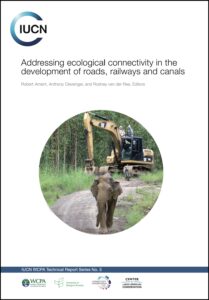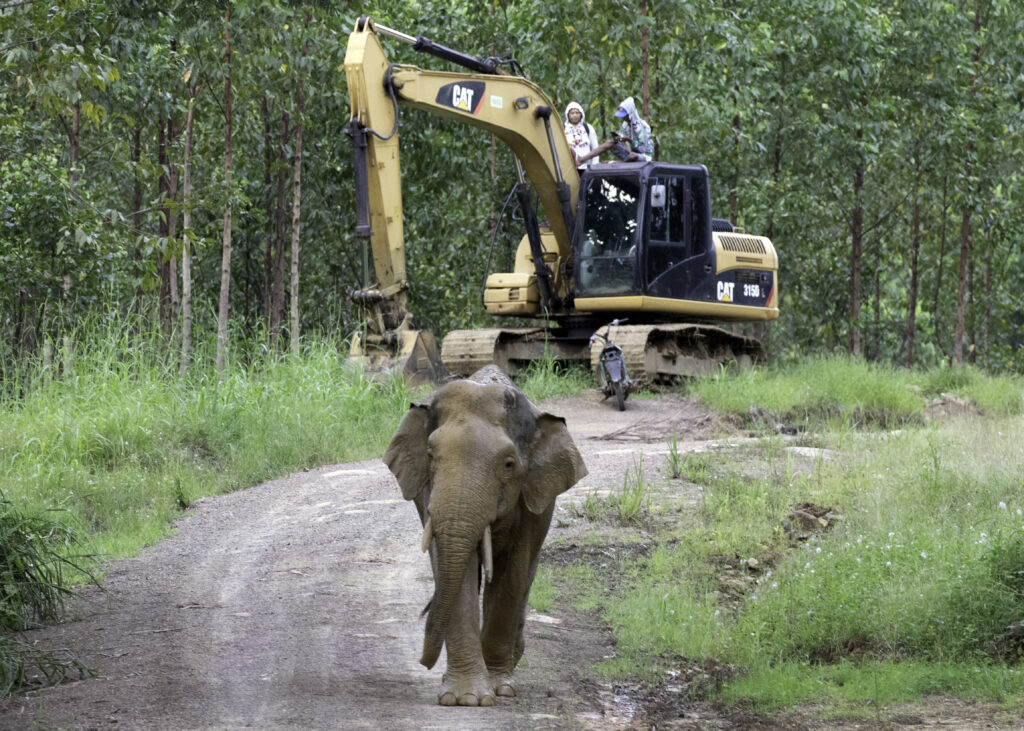Technical report from the IUCN World Commission on Protected Areas highlights best practices for avoiding, minimizing, mitigating, and offsetting impacts of linear transport infrastructure
NEWS RELEASE
 BOZEMAN, MONTANA (18 July 2023) – The planet is experiencing unprecedented levels of land conversion and habitat loss, often in the most biologically rich ecosystems. Despite the well-known societal and economic benefits of infrastructure, indiscriminate development of roads, railways and canals increasingly threatens biodiversity. Endangered Asian elephants are regularly hit by trains; American bison are struck just outside Yellowstone National Park; and road construction opens the door to runaway deforestation, even deep in the Amazon Rainforest.
BOZEMAN, MONTANA (18 July 2023) – The planet is experiencing unprecedented levels of land conversion and habitat loss, often in the most biologically rich ecosystems. Despite the well-known societal and economic benefits of infrastructure, indiscriminate development of roads, railways and canals increasingly threatens biodiversity. Endangered Asian elephants are regularly hit by trains; American bison are struck just outside Yellowstone National Park; and road construction opens the door to runaway deforestation, even deep in the Amazon Rainforest.
Today, the International Union for the Conservation of Nature (IUCN) – the world’s premier biodiversity organization – released its first in-depth publication on the challenges and solutions of safeguarding biodiversity during linear transport infrastructure (LTI) development. The report, by IUCN’s World Commission on Protected Areas’ (WCPA) Connectivity Conservation Specialist Group (CCSG) and its Transport Working Group (TWG), in collaboration with the Center for Large Landscape Conservation, addresses ecological connectivity during the building of roads, railways and canals. It provides information critical for the conservation of wildlife and the protection of nature in the face of rapid LTI development sweeping the globe.
Addressing ecological connectivity in the development of roads, railways and canals provides an overview of practical, feasible, science-based strategies for protected and conserved area (PCA) managers, transport practitioners, industry, conservationists, and other interested stakeholders to reduce the impacts of infrastructure on the environment. From planning and design to construction, operations, and monitoring, the report synthesizes the state of the field and offers a way forward.
Ecological connectivity is defined as the unimpeded movement of species and the flow of natural processes that sustain life on Earth. Fragmentation of landscapes caused by human activities such as LTI development disrupts this connectivity that is essential for healthy ecosystems.
The unprecedented rate of LTI development such as roads, railways and canals is a key driver of global biodiversity decline. Direct impacts include habitat degradation, fragmentation and loss, species mortality, and the creation of physical barriers and filters to wildlife movement and ecological flows. Other impacts include pollution from noise, light, vibration and chemicals, air and water quality degradation, the spread of invasive alien species and changes in hydrology and microclimate. As intact areas with high biodiversity values become more accessible, an assortment of indirect problems can arise, such as increased rates of poaching; illegal mining, logging, and other extractive industries; increased frequency and intensity of wildfires; land speculation; and illegal settlement.
Addressing these impacts requires more focused attention, increased technical skills, and a better-trained workforce as the demand for LTI grows precipitously around the world, especially in developing countries. Planners and decision-makers must strike a balance between the anticipated socio-economic benefits of LTI with the challenges of safeguarding healthy ecosystems, ecological connectivity, and biodiversity.
This report takes inspiration from the great diversity of local, national, and transboundary connectivity conservation efforts already underway. In recent years, the importance of ecological connectivity has been recognized in international policy as a critical component of safeguarding biodiversity and building resilience to climate change, most notably in the adoption of the Global Biodiversity Framework. The technical report also builds on the 2020 publication of IUCN Guidelines for conserving connectivity through ecological networks and corridors, which laid out the imperative for conserving ecological connectivity to maximize the effectiveness of PCAs. In so doing, the 2020 Guidelines underscored the importance of avoiding and mitigating the impacts of LTI on connectivity; now this technical report provides the roadmap for practitioners.
Over the course of more than three years, Addressing ecological connectivity in the development of roads, railways and canals has benefited from contributions from over 30 experts from six continents. It is expected to increase awareness and inspire commitment, the allocation of resources, good governance, and effective policies. Combined, these actions will contribute to more successful conservation, sustainable livelihoods, and resilient landscapes.
Addressing ecological connectivity in the development of roads, railways and canals is the fifth volume in the IUCN WCPA Technical Report Series.
Access and download the Technical Report from the IUCN Library at this link: www.doi.org/10.53847/IUCN.CH.2023.PATRS.5.en
Quotes:
“Many countries are struggling to protect nature as they develop LTI. We hope the guidance provided in this Technical Report will inspire them to improve their policies and practices.” – Robert Ament, Senior Conservationist, Center for Large Landscape Conservation and Co-Chair, IUCN WCPA CCSG Transport Working Group
“A key driver of biodiversity decline is the unprecedented global rate of linear transport infrastructure development, highlighting a critically urgent need to develop workable solutions. This technical guidance is hugely relevant to practitioners grappling with the issue of maintaining ecological connectivity and integrity within protected and conserved area systems.” – Dr. Madhu Rao, Chair, IUCN World Commission on Protected Areas
“This report comes at a pivotal time. There is strong, global recognition of the importance of ecological connectivity as a key priority for addressing biodiversity loss. Addressing ecological connectivity in linear transport infrastructure will not only benefit millions of migratory animals across the planet, it will also contribute to the implementation of the Kunming-Montreal Global Biodiversity Framework, and other global challenges. ” – Amy Fraenkel, Executive Secretary of the Convention on the Conservation of Migratory Species of Wild Animals
About the International Union for Conservation of Nature (IUCN)
IUCN helps the world find pragmatic solutions to our most pressing environment and development challenges. IUCN works on biodiversity, climate change, energy, human livelihoods and greening the world economy by supporting scientific research, managing field projects all over the world, and bringing governments, non-governmental organisations, the United Nations and companies together to develop policy, laws and best practices. IUCN is the world’s oldest and largest global environmental organisation, with more than 1,400 members from government and non-governmental organisations and more than 15,000 volunteer experts. IUCN’s work is supported by around 950 staff in more than 50 countries and hundreds of partners in public, non-governmental organisations and private sectors around the world. www.iucn.org
About the IUCN World Commission on Protected Areas (WCPA)
IUCN’s World Commission on Protected Areas (WCPA) is the world’s premier network of protected and conserved areas expertise. The Commission has over 2,500 members spanning 140 countries who provide strategic advice to policymakers and work to strengthen capacity and investment for protected areas establishment and management. The Technical Reports series is one of the Commission’s flagship products, providing timely guidance on aspects of protected area planning, management and assessment. Learn more
About the WCPA Connectivity Conservation Specialist Group (CCSG)
CCSG was established in 2016 under the IUCN World Commission on Protected Areas (WCPA) to support information sharing, active participation, global awareness, and action to maintain, enhance, and restore ecological connectivity conservation around the world. Its objective is to advance the science, policy, and practice at international, national, and subnational levels to meet the growing demand for solutions that advance the identification, recognition, and implementation of consistent connectivity conservation measures. Learn more at CCSG page and www.conservationcorridor.org/ccsg
About the Center for Large Landscape Conservation (CLLC)
CLLC develops solutions, implements projects and contributes to global efforts that connect and protect crucial habitat across terrestrial, marine and freshwater ecosystems. It provides expertise through four key focus areas: science, policy, mentorship and networking, and on-the-ground project implementation. By bringing knowledge and experience to bear on connectivity conservation issues worldwide, the Center works with communities, governments and other stakeholders to stop fragmentation and safeguard the legacy of protected and conserved areas by making them part of larger ecological networks for conservation. Learn more at www.largelandscapes.org
###
Contacts: Robert Ament, Anthony Clevenger, and Rodney van der Ree (editors)
For more information about the IUCN WCPA Connectivity Conservation Specialist Group and its Transport Working Group, contact the Secretariat: Gary Tabor, Chair and Aaron Laur, Executive Officer.
Photo: Asian elephant and machinery, Malaysia – CLLC/Gary Tabor



